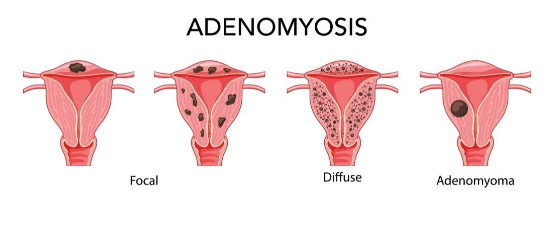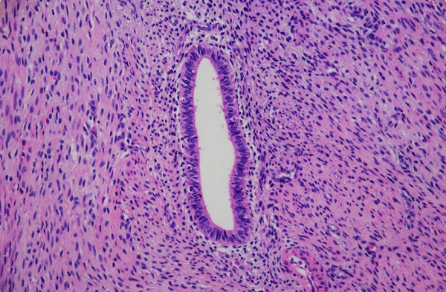Adenomyosis (ad-uh-no-my-O-sis) occurs when the tissue that normally lines the uterus (endometrial tissue) grows into the muscular wall of the uterus. The displaced tissue continues to act normally — thickening, breaking down and bleeding — during each menstrual cycle. An enlarged uterus and painful, heavy periods can result.
Adenomyosis vs Endometriosis
Adenomyosis and endometriosis are disorders that involve endometrial tissue. Both conditions can be painful. Adenomyosis is more likely to cause heavy menstrual bleeding. The difference between these conditions is where the endometrial tissue grows.
- Adenomyosis: Endometrial tissue grows into the muscle of the uterus.
- Endometriosis: Endometrial tissue grows outside the uterus and may involve the ovaries, fallopian tubes, pelvic side walls, or bowel.

Symptoms of adenomyosis?
Many people with adenomyosis don’t have symptoms. Some people experience:
- Painful menstrual cramps (dysmenorrhea).
- Heavy menstrual bleeding (menorrhagia).
- Abnormal menstruation.
- Pelvic pain.
- Painful intercourse (dyspareunia).
- Infertility.
- Enlarged uterus.
How is adenomyosis diagnosed?
Healthcare providers often diagnose adenomyosis based on symptoms and one or more of these tests:
- Pelvic exam: During a pelvic exam, your provider may notice that your uterus has gotten larger, softer, or more painful when palpated.
- Ultrasound: A transvaginal ultrasound uses sound waves to produce images of pelvic organs. These images can sometimes show thickening of the muscle raising suspicion for adenomyosis.
- Imaging scans: Magnetic resonance imaging (MRI) scans can show uterine enlargement and thickening of certain areas of the uterus which can be indicative of adenomyosis.
- Biopsy: Because tissue grows within the uterus walls, the only way to biopsy tissue is after a hysterectomy, which removes the uterus.

How is adenomyosis managed or treated?
Because the female hormone estrogen promotes endometrial tissue growth, adenomyosis symptoms often go away after menopause. In the meantime, these treatments can ease pain, heavy bleeding and other symptoms:
- Pain medications: Nonsteroidal anti-inflammatory drugs, or NSAIDs, such as ibuprofen (Advil®, Motrin®) or naproxen (Aleve®), ease cramping.
- Hormonal birth control: Estrogen thickens the uterine wall and can worsen bleeding and cramping. Certain hormonal contraceptives can stop menstruation and symptoms. Options include birth control pills, Depo-Provera® injection and hormonal intrauterine devices (IUD), such as Mirena®.
- Hysterectomy: This surgery removes the uterus. After a hysterectomy, you won’t have a menstrual cycle or be able to get pregnant.
What are the complications of adenomyosis?
Heavy menstrual bleeding from adenomyosis increases your risk of anemia. Anemia occurs when your body doesn’t have enough iron-rich red blood cells. You may feel chronically fatigued or cold.
How does adenomyosis affect pregnancy?
Adenomyosis tends to affect women who have had at least one child. However, the condition may make it difficult to conceive for the first time or to have another child. Infertility treatments may help. Once pregnant, there is an increased risk of:
- Miscarriage (loss of2w pregnancy before a baby fully develops).
- Premature labor (childbirth before the 37th week of pregnancy).
How can I prevent adenomyosis?
Because no one knows what causes adenomyosis, healthcare providers don’t know of anything you can do to prevent it.
When should I call the doctor?
You should call your healthcare provider if you experience:
- Extremely heavy periods.
- Severely painful cramps.
- Painful intercourse.
What questions should I ask my doctor?
If you have adenomyosis, you may want to ask your healthcare provider:
- Why did I get adenomyosis?
- What is the best treatment for me?
- Should I use a different birth control method?
- Will I be able to get pregnant?
- Should I look out for signs of complications?


